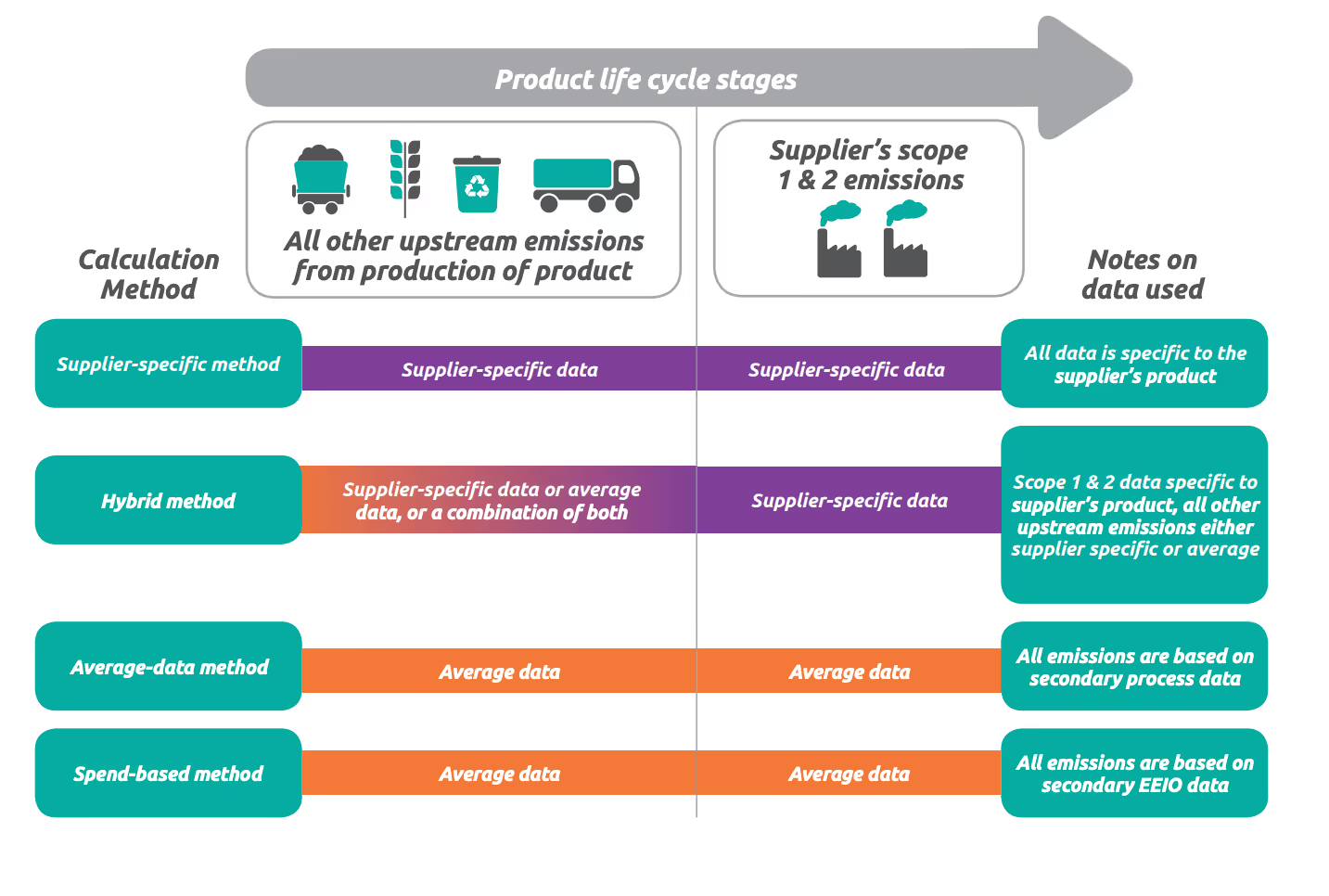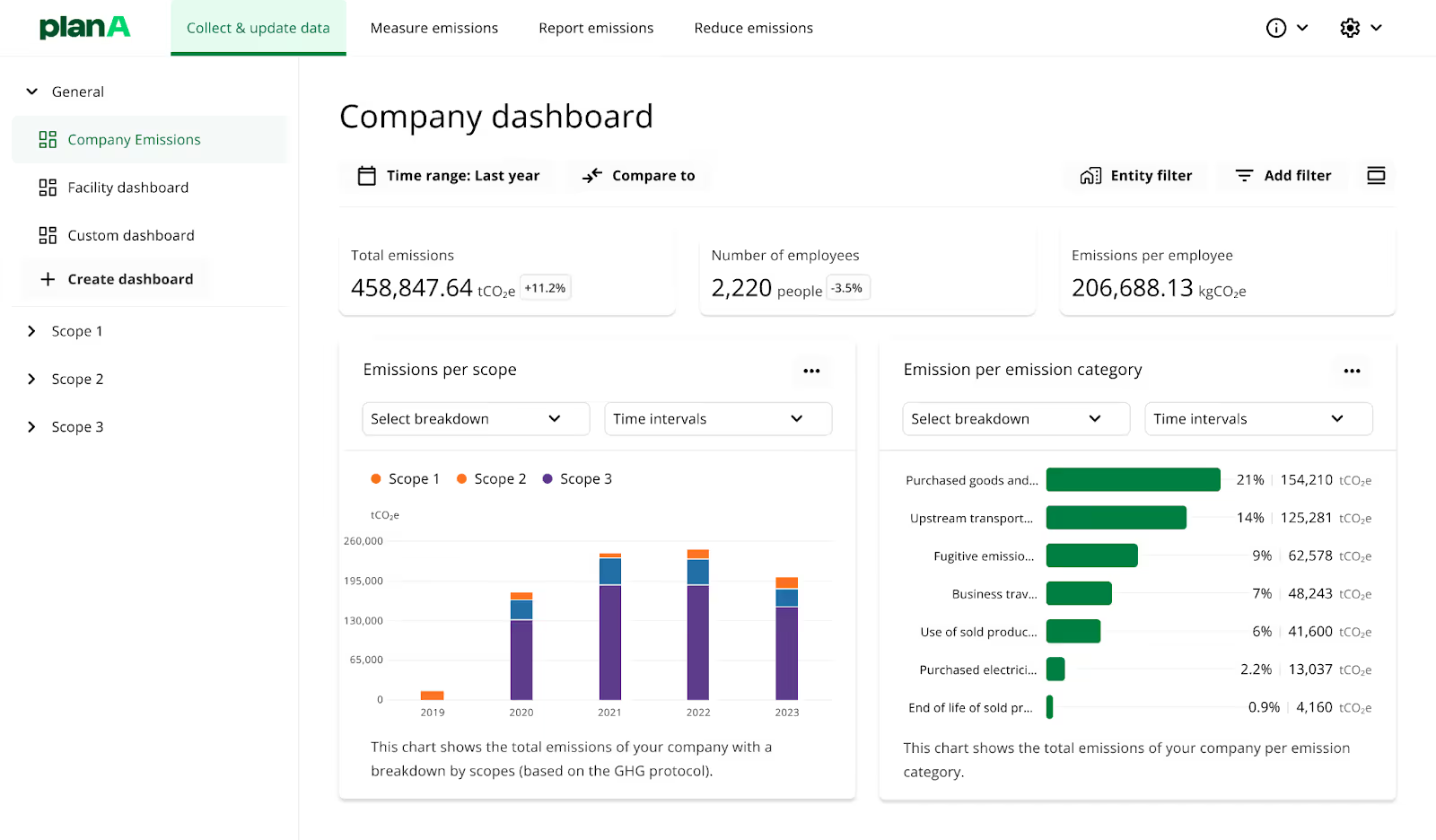When companies focus on their carbon footprint, they usually investigate what's happening within the energy they use or the waste they produce. But what about the emissions linked to the goods and services they purchase? This is where Scope 3 Category 1 emissions need to be studied.
In many ways, Scope 3 emissions coming from purchased goods and services (category 1) act as an invisible thread, connecting a company to its broader environmental impact. This fact means every product bought and service used has a hidden carbon cost.
Understanding and managing these emissions allows businesses to cut down carbon at the source, rethink their procurement processes, and work closely with suppliers with the same environmental values. This is where real change begins, and businesses can indeed lead in mitigating carbon emissions and climate change impacts.
What are purchased goods and services emissions (Scope 3 Category 1)?
Before calculating your company’s emissions and carbon footprint, you need to understand better what makes up the “purchased goods and services emissions” included in Scope 3 Category 1.
Defining purchased goods and services emissions (Scope 3 Category 1)
Purchased goods and services emissions, classified under Scope 3 Category 1, represent all the upstream greenhouse gas emissions (GHG) linked to the products and services a company acquires. They are a part of GHG emissions scopes and categories.
Good to know: Category 1 of Scope 3 is extensive because it includes the full range of emissions generated by:
- The initial extraction of raw materials,
- The manufacturing processes,
- Transportation,
- The disposal of waste (used to deliver these goods and services to the company).
This is why Scope 3 Category 1 emissions significantly impact a company's overall carbon footprint. They represent a substantial part of the total emissions while remaining less visible than direct emissions from the company’s operations.
Importance of Scope 3 Category 1 emissions
Scope 3 Category 1 emissions include an essential proportion of a company’s emissions. In many cases, the carbon footprint associated with purchased goods and services can exceed the one related to the company’s direct operations.
Unlike Scope 1 and Scope 2 emissions, which are directly related to a company’s operations, Scope 3 Category 1 emissions are usually linked to various suppliers and partners, making them more challenging to identify and manage.
As a result, supply chain management becomes more delicate. It necessitates a proactive approach when selecting suppliers and encouraging them to improve their emissions performance. The goal is to drive more sustainable practices throughout the value chain and reduce emissions.
Corporate responsibility is also highly intertwined with how well a company manages its Scope 3 emissions. Despite the customers, investors and other company partners (even regulators) are giving more and more importance to the accountability companies take regarding their emissions. Now, companies must include setting science-based targets aligned with global climate goals, yes, but especially with their goal of reducing the carbon impact of their purchased goods and services.
The benefits of measuring Scope 3 emissions include:
- The identification of emission hotspots: Measuring Scope 3 emissions allows businesses to identify where the most important emissions are produced within their value chain and then prioritise their reduction strategies to have the greatest impact;
- The access to supplier performance insight: If your company starts to evaluate its emissions associated with purchased goods and services, you will be able to identify which suppliers are excelling in sustainability and which are falling behind;
- Access to supplier performance insight: Detailed knowledge of Scope 3 emissions allows you to make more informed and strategic decisions regarding procurement, product development, and logistics. It means that your company will easily target interventions that lead to the most significant reductions in emissions;
- The development of driving innovation: This innovation is an excellent way to reduce the company’s emissions and to adapt the company’s strategy to the growing consumer demand for environmentally responsible products;
- Optimising the company’s climate strategy: Thanks to tangible and quantifiable changes that can be communicated to stakeholders or consumers, your company can prove its commitment to sustainability.
How can companies calculate purchased goods and services emissions?
Supplier-specific method, hybrid method, average-data method. Here are the best methods to calculate your company’s Scope 3 Category 1 emissions.
Best methods for calculating Scope 3 Category 1 emissions

Calculating the emissions related to purchased goods and services requires careful consideration of available data and resources. The accuracy of these calculations is directly linked to the quality of the collected data, as they must account for the entire lifecycle of the products and services a company acquires.
To help you in this process, here are the 4 primary methods that you can use:
- Supplier-specific method: Start by collecting detailed cradle-to-gate greenhouse gas (GHG) data directly from your suppliers to have the most precise emissions data tailored to the specific goods purchased;
- Hybrid method: This approach combines supplier-specific data with secondary data to address gaps where supplier information is incomplete or unavailable. As a result, it will give you a more balanced and comprehensive calculation;
- Average-data method: Using industry averages is another method that will estimate your Scope 3 Category 1 emissions regarding the mass or relevant units of the purchased goods. Even if this method is less precise than the previous ones, it’s a practical solution when detailed supplier data is not accessible;
- Spend-based method: This last method estimates emissions based on the economic value of the purchased goods, which is particularly useful if you don’t have product-specific data.
Of course, each method has advantages and limitations. The choice of the correct method depends on the level of detail and accuracy that your company requires and the resources you can dedicate to data collection and analysis.
The role of carbon accounting software in optimising the use of emission factors

In simple terms, carbon accounting software is a powerful tool designed to help businesses track, manage, and reduce their greenhouse gas emissions (GHG) with precision and ease.
It takes the operational data your business already collects (like energy consumption or fuel use) and matches it with the relevant emission factors, which work as conversion rates, transforming your company’s activities into carbon emissions.
Here, automation is key. Why? Without the manual treatment of the whole data, your company will reduce the risk of human error while benefiting from the regular updates of the software with the latest emission factors from trusted sources like the IPCC and the GHG Protocol, meaning that you have the guarantee that your calculations are always based on the most current data!
For business leaders and companies in general, carbon accounting software offers several key advantages such as:
- Automated data matching with emission factors: The software automatically aligns your operational data with the relevant emission factors, depending on the type and source of emissions. As a result, your GHG calculations are consistently accurate;
- Comprehensive and detailed data coverage: This kind of software also provides granular tracking across all emission sources within your company. It means that you will access a detailed view of your carbon footprint, from energy use to transportation;
- Up-to-date emission factors: One of the biggest challenges in manual carbon accounting is keeping track of the latest emission factors. Carbon accounting software regularly updates its emission factor databases automatically, with no need for manual updates.
For what industries are Scope 3 Category 1 emissions crucial?
Now that we have discussed the importance of Scope 3 Category 1 emissions, learning about the industries genuinely impacted by these emissions remains crucial.
What industries are impacted most by Scope 3 Category 1 emissions?
Scope 3 Category 1 emissions are particularly critical for industries like manufacturing, retail, and construction, where the upstream emissions from purchased goods and services represent a significant portion of their overall carbon footprint.
Scope 3 Category 1 emissions particularly impact every specific sector due to the types of goods and services usually purchased. Here are a few examples:
- Manufacturing: Raw materials (metals, plastics, textiles), components, machinery for production;
- Retail: Consumer goods (apparel, electronics), packaging materials for product distribution, transportation and logistics services;
- Construction: Building materials in general (cement, steel, timber).
Importance of industry-specific strategies
Industry-specific strategies represent the specific challenges and opportunities faced by a given industry. For example, manufacturers can make a significant impact by choosing low-carbon materials, while retailers can work closely with their suppliers to avoid packaging waste.
What makes these efforts powerful? Collaboration across industries! When companies share some excellent tips about what’s working and what’s not working to reduce Scope 3 Category 1 emissions, they can use their collective buying power and push for more sustainable products and services on a larger scale. As a result, they drive innovation and strengthen their supply chains.
How can companies reduce purchased goods and services emissions?
Here are some key strategies companies can use to reduce emissions from purchased goods and services:
- Engage more with suppliers: Work closely with your suppliers to help them adopt more sustainable practices, such as using low-carbon materials and improving energy efficiency;
- Adopt sustainable procurement policies: Implement procurement policies that prioritise the purchase of goods and services with lower carbon footprints;
- Regularly monitor and report emissions: Take the habit of tracking and reporting the emissions associated with your purchased goods and services, which will help you to identify some possible improvements;
- Focus on reducing emissions directly at their source: Prioritise actions that directly reduce emissions within your supply chain to ensure long-term benefits;
- Encourage innovation: Finally, remember to promote the development of new low-carbon technologies that can significantly reduce emissions in the long run!
Scope 3 Category 1 emissions: The takeaways
The primary information to keep in mind about Scope 3 Category 1 emissions are:
- Massive impact on your carbon footprint: Scope 3 Category 1 emissions cover all upstream emissions from the goods and services you purchase. This includes everything from raw material extraction to waste disposal, meaning these emissions can make up a significant portion of your total footprint, often much more extensive than what you emit directly;
- Indirect but extremely important to address: Even though these emissions aren’t from your operations, they still count heavily. Scope 3 emissions can even far exceed your direct Scope 1 and 2 emissions, making them a priority if you're serious about sustainability ;
- Supplier collaboration is non-negotiable: Cutting Scope 3 emissions means working closely with your suppliers to ensure they are also committed to lowering their carbon footprint. Without their involvement, achieving real reductions will be a challenge ;
- Tackling Scope 3 drives innovation and profit: Remember that managing these emissions improves sustainability, drives innovation, cuts costs, and enhances your company’s reputation.
Calculate your company's Scope 3 Category 1 emissions with Plan A's carbon accounting software. Book a demo and try it out.
.avif)


